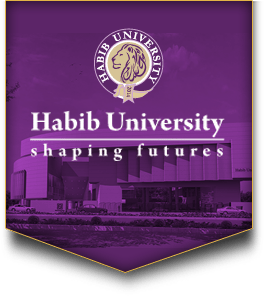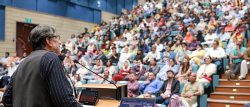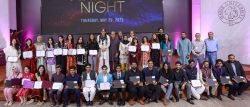Habib University recently held a three day workshop hosted by celebrated Kathak icon Farah Yasmeen Shaikh, for the students of HU. The workshop, conducted on 29th, 30th March and 1st April, was a great success with students as well as staff, and helped them understand the deep roots and traditional aspects of Kathak dancing. Ensuring a transdisciplinary learning environment exists at Habib University remains one of its clearest missions, the impact of which is felt throughout the student body. Performance arts, as well as maintaining a strong connection to the roots of arts and culture of Pakistan, remains a great source of inspiration to the philosophy at HU, and is the reason why the Kathak Dance workshop was arranged.
Farah Yasmeen Shaikh is a rising name in the world of dance, and lit up the stage with poise and grace as she taught the students the fundamentals of the Kathak dance. Having trained under the late Kathak icon, Pandit Chitresh Das, Farah has been gaining international acclaim as a solo artist, touring to global locations to sold-out shows where she displays her original choreographic works. Some of her recent shows include her 2015 premiere of The Twentieth Wife at Z Space in San Francisco, where she exhibited an evocative and thoughtful form of storytelling, regaling the audience with the tale of Empress Noor Jehan through a full-length performance of dance, live music, multimedia and live narration based on the author Indu Sundaresan.

Ms. Yasmeen visited Habib University for the first time on March 26th for an invite-only performance, she said “From the moment I pulled up into the campus I was really impressed, there’s just something really impressive about the facility itself. I knew I had walked into a place professional yet very motivating and inspiring. Even seeing the quotes on the elevators has inspired me”. The staff and students undertaking the workshop honored her with a warm and supportive welcome, making sure her performance as well as the training sessions were enjoyable for both. “There seemed to be a lot of positive response. Little by little the surprise is wearing off but at the same time I forget that the reference point of the classical dance forms specifically of Kathak is not necessarily there in Pakistan”.
Speaking of the history of performance arts in Pakistan, she said:
Pakistan has gone through a lot of political influence and that has really made an impact on the arts and in the latter 70s and 80s it really squelched what was possible as far as what could happen in the artistic realm specially dance music. So I come from a place where I sometimes make the assumption that people would have this reference point and I’m really surprised but it’s an opportunity to introduce people and there’s a joy in that.

Students attending the workshop left feeling energized, and appreciated the transdisciplinary nature of education at Habib University. “I never thought I’d get to experience Kathak dancing when I joined Habib University, it was a wonderful experience and helped us delve into the history of performance arts, as well as learning the intricacies of the art itself. It is especially encouraging that we, as part of the HU community, get to step out of our comfort zone and learn of the rich heritage of South Asia”, said Shayaan Aijaz, Class of 2019.
Teaching students, staff and faculty of #HabibUniversity in #Karachi #Pakistan an introductory 3-day #kathak workshop…
Posted by Farah Yasmeen Shaikh on Wednesday, March 30, 2016
At the end of the 3 day workshop, Ms. Yasmeen said, “It is quite humbling to be a bearer of the tradition and bring it back to a broader sense of its origin and know that it is actually being introduced in some ways for the first time. Overall the experience has been really exciting, I love the environment here and the methodology in general of what the students are being offered and how they’re being taught. To be a part of all of that whenever possible I hope it continues. I was highly impressed by the participants of the workshop of whom many took a dance class for the first time, and we didn’t have a mirror but they were learning so much new terminology in relation to the music and dance. In six hours they learnt, although not yet refined and polished, but they were open and that’s the greatest gift for anybody who teaches, when the mind and body can be open enough to receive that knowledge and instruction”.





